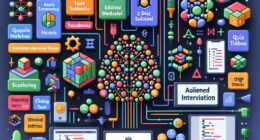MIL-OSI: NVIDIA Powers Up Quantum Computing Initiatives at Australia’s Premier Supercomputing Hub
In a groundbreaking development poised to revolutionize quantum computing, NVIDIA has announced its collaboration with the Pawsey Supercomputing Research Centre in Australia. By integrating the cutting-edge NVIDIA® CUDA Quantum platform with NVIDIA Grace Hopper™ Superchips, the National Supercomputing and Quantum Computing Innovation Hub is set to escalate its quantum computing research to unprecedented levels.
Located in Perth, the Pawsey Supercomputing Centre will harness the capabilities of CUDA Quantum—an open-source platform designed for hybrid quantum computing. This platform not only offers powerful simulation tools but also supports programming across hybrid CPU, GPU, and QPU systems. The NVIDIA cuQuantum software development kit will complement these efforts, providing optimized libraries and tools to expedite quantum computing workflows.
The core of this technological advancement lies in the NVIDIA Grace Hopper Superchip. This superchip merges the powerful NVIDIA Grace CPU with the Hopper GPU architecture, facilitating high-fidelity and scalable quantum simulations. Its design is aimed at seamlessly meshing with future quantum hardware, setting a new benchmark in computing performance.
Highlighting the significance of this partnership, Tim Costa, the director of HPC and quantum computing at NVIDIA, emphasized the pivotal role of high-performance simulation. Costa noted that these technological feats are crucial for overcoming key challenges in quantum computing—ranging from algorithm discovery to device design and the development of error correction and control methods.
Mark Stickells, executive director at the Pawsey Supercomputing Research Centre, underscored the facility’s role in propelling scientific advancements not only within Australia but globally. With the integration of NVIDIA’s CUDA Quantum platform, researchers are now poised to push the frontiers of quantum computing research.
The Commonwealth Scientific and Industrial Research Organisation (CSIRO) projects the Australian quantum computing market to potentially generate $2.5 billion in annual revenue and create 10,000 new jobs by 2040. Embedded quantum computing in various scientific domains—such as astronomy, life sciences, medicine, and finance—will be pivotal in realizing this vision.
The Pawsey Centre intends to utilize this system for running a myriad of quantum workloads, leveraging classical high-performance computing systems. This integration aims at developing hybrid algorithms that optimize calculations by dividing them between classical and quantum processes, thus enhancing computing efficiency. Initial explorations will delve into quantum machine learning, chemistry simulations, and numerous other fields.
Equipped with eight NVIDIA Grace Hopper Superchip nodes, the centre stands at the forefront of computational technology. The GH200 Superchips are a marvel of engineering, eliminating the need for traditional CPU-to-GPU connections. This not only multiplies the bandwidth between GPU and CPU by seven times compared to the latest PCIe technology but also promises a tenfold increase in performance for data-intensive applications.
Committed to furthering quantum research, the Pawsey Centre plans to make these advanced computing resources accessible to the Australian quantum community and its international collaborators.
About NVIDIA:
Since its inception in 1993, NVIDIA has led the way in accelerated computing. The company’s pioneering development of the GPU in 1999 catalyzed the growth of the PC gaming market, transformed computer graphics, and ignited the modern AI era, paving the way for a new industrial digitalization. As a full-stack computing infrastructure company, NVIDIA continues to redefine industry boundaries, offering data-center-scale solutions that are revolutionizing various markets.










